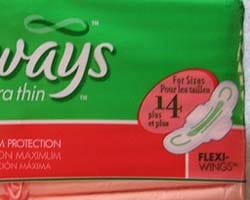
By: Susie Hewson
Every year over 45 billion feminine hygiene products are dumped somewhere. This means that over 12 billion sanitary pads and liners are buried in landfill or incinerated every year in the United States and Canada. It takes approximately 500 years for a pad to break down into tiny pieces in a landfill site. This breaking down into small pieces is called Degrade and is very different to the process where things Biodegrade.
If you leave food out of the fridge for a short amount of time, it will start to rot. Out in the garden, in the soil or on a compost heap, the end result of that rotting would not be seen or even distinguished from the soil where it lay. This is because the vegetable matter is biodegradable. It breaks down into the same particles that the soil is made up of. Synthetic materials such as plastic, polypropylene, and polyethylene are manufactured materials produced from crude oil, and they can never biodegrade. The materials stay in our environment forever, even if they break down into tiny pieces after hundreds of years, they will still be there to measure and pollute the soil and our water.
Over 90% of a sanitary pad is made of crude oil plastic; the rest is made from chlorine-bleached wood pulp. If you think about the impact on our environment of making the absorbent material that fills out the pad, which includes chopping down large areas of forests to source the wood and then chlorine bleaching the pulp, the use of crude oil plastic is a massive burden on the environment. We are rightly concerned about the billion plastic shopping bags given away daily, but by using plastic laden feminine hygiene products, each year we add the equivalent of 180 billion plastic bags to our waste stream.
According to the Algalita Marine Research Foundation, 80% of the plastic floating in our oceans comes from land as waste under 5mm passes through the filters and enters our streams, rivers, oceans and the stomachs of birds, fishes and other wildlife. If plastic is burnt in an incinerator, it will release dioxin into the air that we all need to breath, and will eventually go on to also pollute the water we need to drink and the soil that we depend on to grow our food.
What can we do to protect our environment now?
The answer is to use biodegradable plastics made from GM free plant material that will biodegrade after a short time once in the soil as well as only taking wood from ecologically managed forests and responsibly processing with sustainable and environmentally safe chemicals.
When shopping for feminine hygiene products, look for organic and natural options. Your health will thank you for it.




